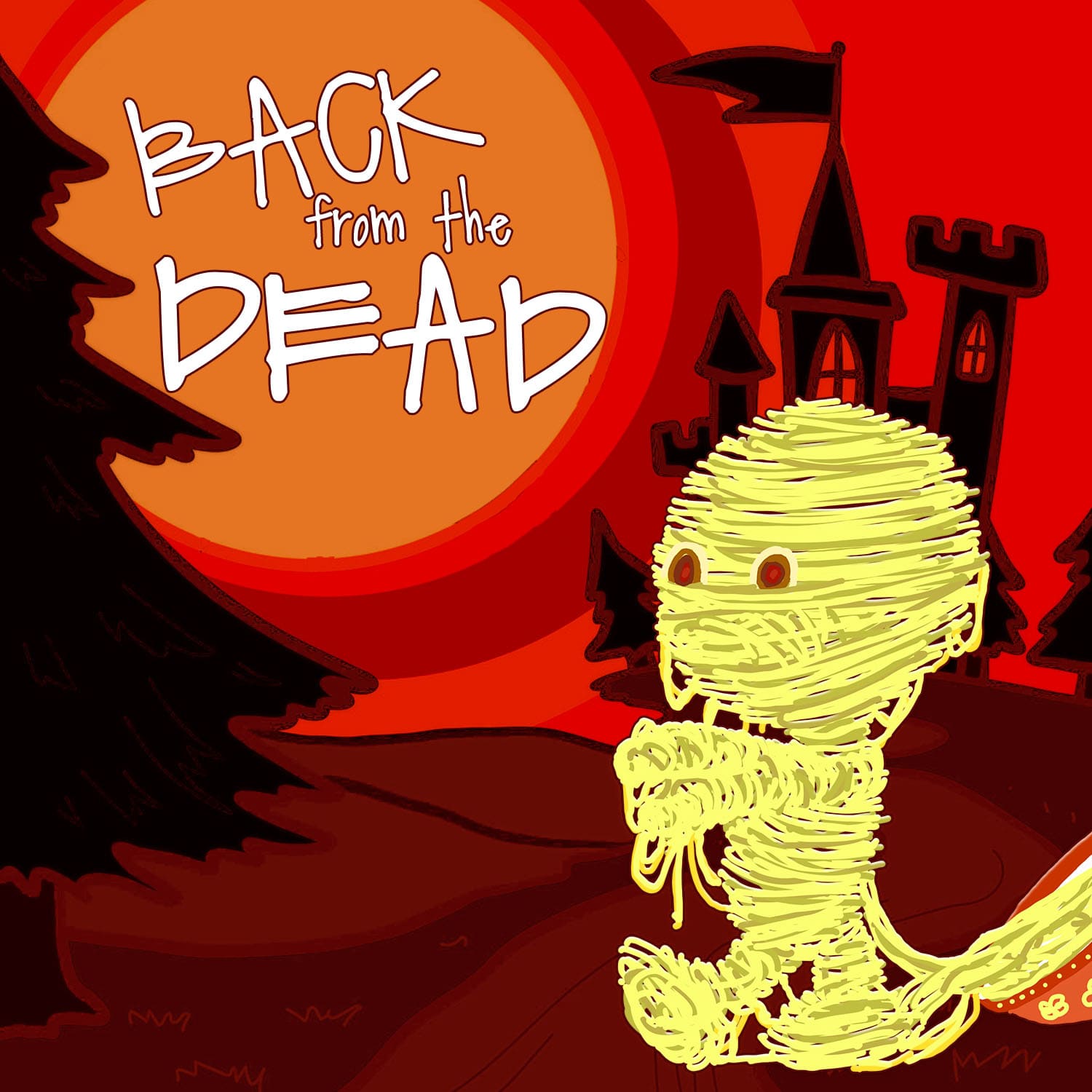
“Nestlé spent three decades building a beloved noodle brand in India. Then the world’s biggest food and beverage company stumbled into a public relations debacle that cost it half a billion dollars.” — Fortune
Nestlé has sold Maggi in India for over 30 years now and it’s one of the most recognised brands in modern India. It accounts for about 23% of the total revenues and its popularity with the millennial segment is perpetually on the rise. And yet, in 2015, when India’s central food regulator, FSSAI announced a temporary ban on the manufacture, sale, and distribution of Maggi noodles, it shook the very foundation of the brand and the company. The crisis was so debilitating that the CEO of the parent company, Nestle S.A, flew down to India in a bid to boost morale at a time when the Nestle India business contributed to a paltry 0.15% to the worldwide business. But despite all this, it’s no secret that Maggi Instant Noodles has seen a resurgence in popularity and is now back to being the market leader and with it, Nestle India has seemingly risen from the ashes to challenge for the top berth in the Fast Moving Consumer Goods (FMCG) space once again.
Now before we delve into the business operations and the financials, readers must bear with us while we take you on a small detour. A subtle detail about the whole crisis is that at its worst, Nestle’s stock price tanked 15%. This was the day Maggi was taken off retailers’ shelves and the ban was enforced — You’d expect the crisis to affect the price more than it did but you must also bear in mind that Nestle, in addition to making Instant Noodles also dabbles with chocolates, baby food and coffee powder in a bid to grow, but more importantly to reduce its dependence on a single brand/product.
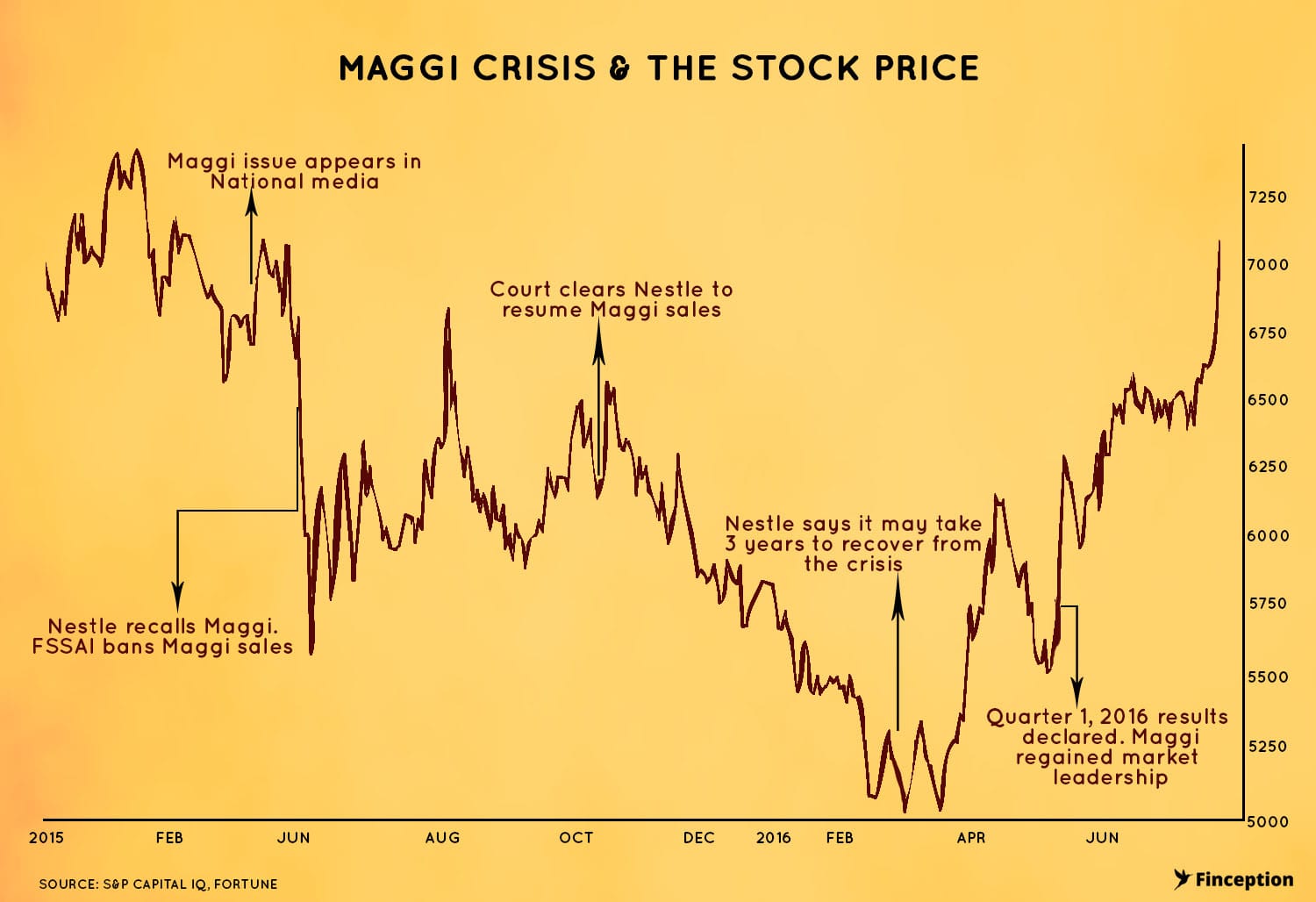
The underlying premise is called diversification. To diversify is to create a safety net in case your prized possession falters and it's not just Nestle. Investors also often employ this technique to reduce their own dependence on individual stocks in a bid to reduce, what economists call unsystematic risk. Unsystematic risk is variation in stock price that arises from factors intrinsic to specific companies. A ban on Maggi affects Nestle alone. It does not affect the outside market and betting on other companies would have reduced the exposure to the ensuing losses. So the risk associated with such variabilities can be reduced by simply diversifying your portfolio i.e. buying a few shares of multiple companies from different sectors as opposed to many shares of just one company. While this move does reduce a lot of the risk associated with investing in stocks, there is a very different kind of risk that you can’t diversify away, a risk that we will address later in the story.
But for Nestle, diversification was a saving grace and even with Maggi gone for 5 months, it continued to stay tall.
While Maggi is, after all, a prominent brand within the company’s portfolio, it doesn't contribute to revenues nearly as much as another core segment — Milk Products and Nutrition. Over the past 5 years, this segment has posted the best growth figures at a compounded annual growth rate (CAGR) of 4.5% and forms about 48% of the total sales. Within the segment, a considerable portion of the revenue comes from Infant Formula, baby food for babies less than a year old. However, this segment offers two rather interesting challenges.
The first problem is that there only so many babies you can feed. As the population of this country plateaus, babies will be hard to come by and potential for growth will be largely limited to this single statistic. The only saving grace is the potential rise in income that will allow more people to buy Nestle’s products, but in any case, we don’t expect exponential growth here despite the company commanding a market share of over 96% thanks to Cerelac and Lactogen. The second challenge is within the regulatory domain. India has laws that specifically prohibit baby food manufacturers from engaging in any type of promotion or marketing for infant formula and several non-governmental organisations, both within and outside India have joined hands to promote breast milk, instead of ready-made formulas. These efforts don't aid Nestle’s cause but despite the severe handicap, baby food manufacturers continue to approach doctors and paediatricians through their medical representatives and the segment continues to trudge along.
Then there’s chocolates and confectionaries. Although a rather delightful product category, this segment has registered a paltry 0.9% CAGR in 5 years. With many failed product launches and intense competition from the likes of Snickers, Ferrero Rocher, Galaxy and Dairy Milk Silk, Nestle continues to remain sidelined. Finally, there is the Powdered & Liquid beverages segment. Nestle maintains a market share of ~50% in the powdered coffee segment with Nescafe while Bru (HUL) occupies the rest. Despite the apparent lack of competition in this segment, growth has been hard to come by in almost every segment and so the company has decided to go on the offensive.
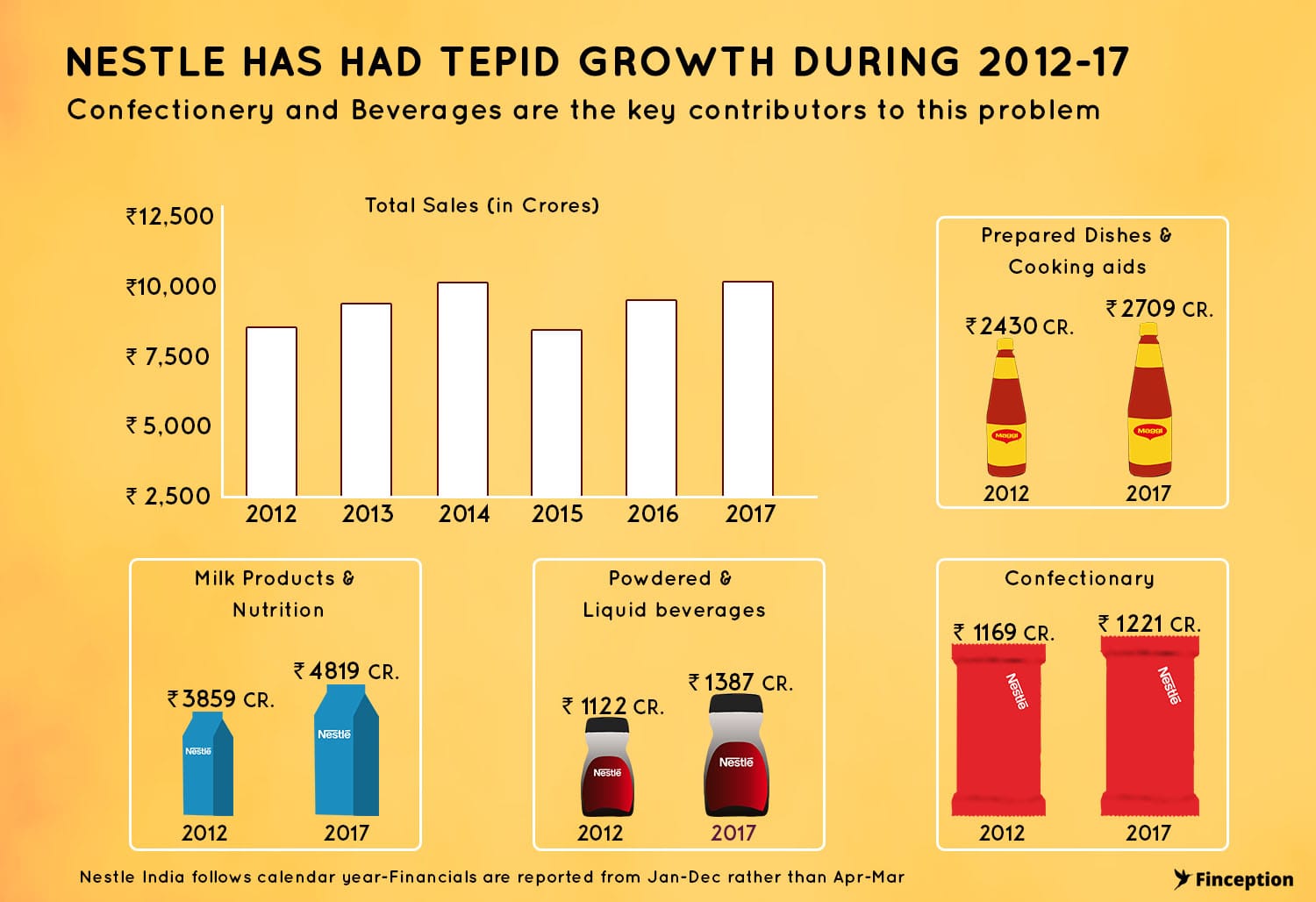
Nestle has been gearing up for a whole host of new product launches to spur growth and redeem its former glory.
Unfortunately, creating and selling new products is an arduous task rife with uncertainties. Nielsen points out that 85% of all consumer packaged goods (CPG) product launches flop. For Nestle, however, it is imperative that it dabbles with new products, even at the risk of failure. It introduced a host of 39 new products between 2016 and 2018. Nielsen’s statistics would tell you that 33 of those launches ought to fail and that is a scary proposition. By Nestle’s own account, 14 out of the 39 new products that went on sale were deemed unsustainable and have since gone off the shelves.
So what happens when products fail? Well, that depends. If the new launches are variants of existing product lines, the kind consumers saw when Nestle launched a spicier version of Maggi called Hot Heads, you’d expect very little fallout in the event that the product flops. This is partly due to the fact that introducing such variants often does not involve significant capital investment. However, if you were introducing a brand new product, say Alpino — a pack of two chocolaty bourbons with a delicious creamy centre that comes with a message of love, you’d need to set aside significant sums of money to produce and pack these supposed balls of goodness and love. If you haven’t heard of Alpino yet, don’t worry, we haven’t either, but the fact that both of us are yet to hear about this product ought to drive home a very important theme.
Things could go south very quickly and introducing new product lines is no easy task. So while diversifying your product mix and trying new things is a welcome strategy, new products don’t necessarily guarantee success and can often have terrible consequences. But that hasn’t bothered Nestle one single bit and for good reason. Before the crisis and the new CEO stepped in, Nestle wasn't really gung-ho on introducing new products. Between 2011 and 2016, the company introduced 29 products in total. Since then, however, we have seen a marked increase in new product launches and their contribution to total sales. Albeit some of these new launches were expected to be “limited edition”, there is a renewed sense of hope amongst investors and analysts alike with improving revenue share from these products.
Note: While Alpino might not have lived up to consumer expectations, Munch Nuts, a crunchy, nutty variant of the popular Munch has outperformed expectations.
However, there is one tiny problem. With all these new product launches you’d expect Nestle to spend exorbitant sums on advertising. But it doesn’, at least that’s what most analysts like to believe.
But first thing’s first. Why would Nestle need to advertise? It’s a well-known brand that sells products that most people are already aware of. Unnecessary spending on advertising is exactly the kind of thing you would want to prune if you aspire to run a tight ship. But FMCG products aren't like other products. A 3 finger KitKat sells for Rs. 20. Consumers hardly spend time in making purchase decisions characterised by such small ticket sizes and so it is imperative that the product stays on top of consumers’ minds. Advertisements help in driving home this point. Typically more ads mean better brand recall which the company could then translate into sales. FMCG giants including HUL and GSK spend liberally on ads and it is quite strange that Nestle has adopted a policy that is seemingly at odds with conventional wisdom.
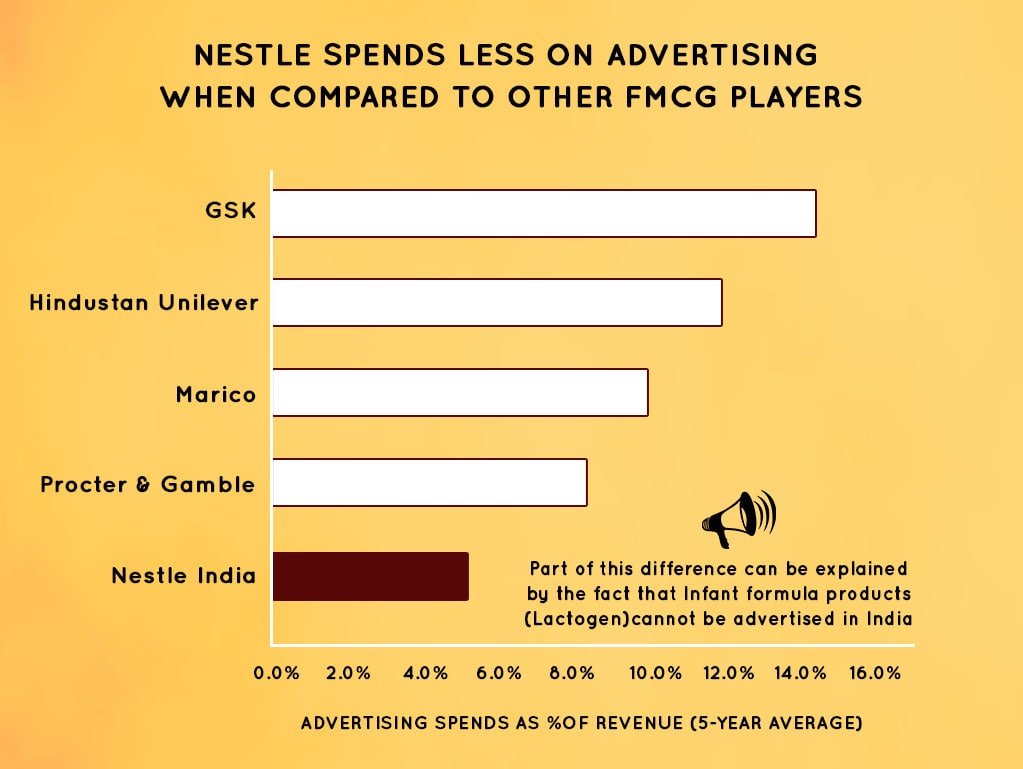
Nestle’s Chief Managing Director, Suresh Narayan had this to say about the matter and we are paraphrasing him here — “ We are in the foods business. Eating habits take time to change and we want to be judicious with our ad spends.” Well, that is partly true. When it comes to Food & Beverages, people do tend to develop an affinity for particular brands that could potentially stand the test of time. Consider the case of Maggi. Within just one year of the crisis, Nestle regained most its market share in the instant noodles segment — in no small part thanks to customer loyalty. So, there is some stickiness. However, when competitors continue to market aggressively, this seemingly infallible loyalty falters. Nestle’s confectionery segment tells you the other side of the story. As we have already noted, growth has largely remained muted and Nestle has been losing market share to players like Cadbury who continue to churn out new product variants and spend aggressively on ad campaigns. So we are not quite sure if this is, after all, a prudent strategy.
What is perhaps evident is that Nestle is unlikely to change its opinion. While this move does help improve profit margins, it’s anybody's guess if it’s the most optimal strategy for growth. However, despite the negatives, Nestle and its peersclass="link__styled" target="_blank" target="_blank" continue to be some of the most expensive stocks in the market seemingly defying all logic. But why?
A common denominator that underscores most FMCG stocks is that they are expensive. If you wanted to buy a share of Nestle today, you’d be paying about 60 times the earnings you are theoretically entitled to i.e. the company boasts a P/E of 60, based on CY 2017 earnings. These are exorbitant figures and we see the same pattern across the spectrum i.e. with Marico, Hindustan Unilever etc. But why would investors pay such a high price for what seems like a regular run-of-the-mill company making baby food? Is this all irrational exuberance or is there more to this story than what meets the eye.
We believe that it’s simply the nature of the FMCG business that allows stocks like Nestle to command a premium. Investors seek protection and stability during an economic recession. Imagine you are a middle-income consumer trying to nick a living during these hard times. You would happily forego your vacation and that nice furniture set you were looking to buy, to save some extra cash. But you wouldn’t cut down on baby food or household supplies. So even during periods of muted growth, companies like Nestle will continue to post reasonable sales figures. This, in turn, provides most FMCG companies with some immunity during a recession. But investors must also bear in mind that the same is true during periods of excess as well. It’s highly unlikely that the middle-income consumer will now buy abnormal quantities of baby food simply because his income levels rise. So the sales figures don’t necessarily increase in tandem with the market during an economic boom and it is likely that the stock price will follow suit.
While we have already addressed unsystematic risk, you are now about to delve into what economists and stock market gurus call ‘systematic risk’. Systematic or market risks capture the reaction of individual stocks to general market swings. Some stocks are more sensitive and swing wildly as the market moves, while others are relatively less sensitive like Nestle and this little comparison is measured using a numerical figure that money managers call ‘beta’. If a stock has a beta of 2, it means that on average the stock price is likely to swing twice as far as the market. Nestle has a beta of less than 1, so it swings less on average and is, therefore, a much safer bet. A guaranteed rupee is always more valuable than an uncertain one and most large FMCG companies offer you relatively less risky returns. This combined with low debt, stable cash flows and a proven track record is perhaps why Nestle trades at such high prices.
Pro Tip: Pro Tip: Investors must bear in mind that it is extremely difficult to approximate beta. More often than not this number quantifies the subjective feelings of analysts and fund managers and you can obtain very different beta values depending on who you trust.
Despite the low advertising spends, muted growth in multiple product segments and a death blow to its star brand, Maggi, Nestle continues to be a top player in the FMCG space and is now in line to post its best earnings figure in the current calendar year.
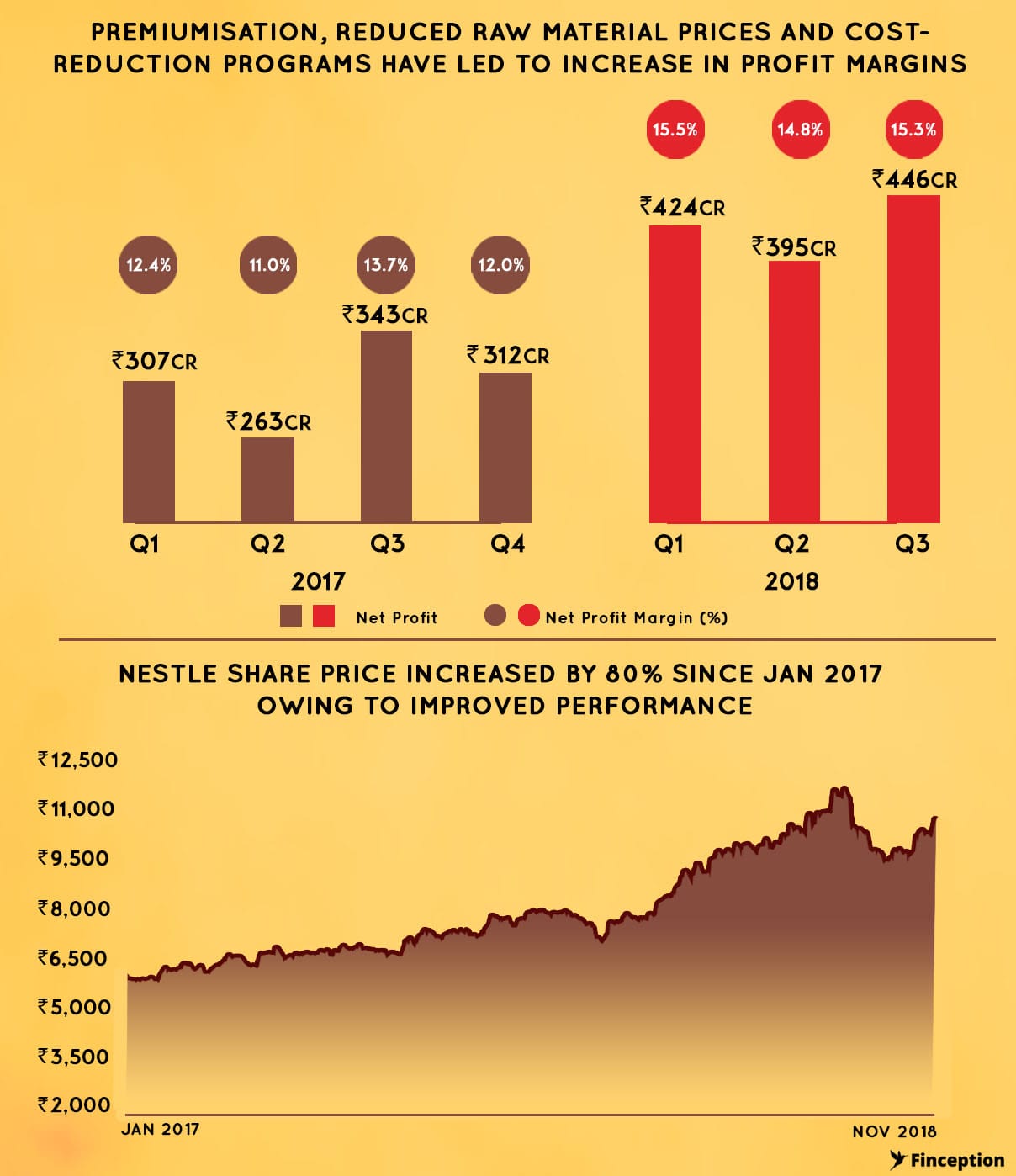
A combination of declining raw material costs, better sales and an optimised distribution strategy have driven the stock price to new historic highs and there is renewed optimism about a company which, for a good half of the past decade was seen as a burgeoning company with limited scope for growth. How much of this will actually translate into real earnings? Well, we don't really know. But what we do know is that Nestle continues to be a giant and with India’s consumption story all possibilities are open.
. . .
Suggested Reading: A Random Walk Down Wall Street by Burton Malkiel
Disclaimer: No content on this website should be construed to be investment advice. You should consult a qualified financial advisor prior to making any actual investment or trading decisions. The author accepts no liability for any actual investments based on this article.
Liked what you just read? Get all our articles delivered straight to you.
Subscribe to our alertsREAD NEXT
Get our latest content delivered straight to your inbox or WhatsApp or Telegram!
Subscribe to our alerts